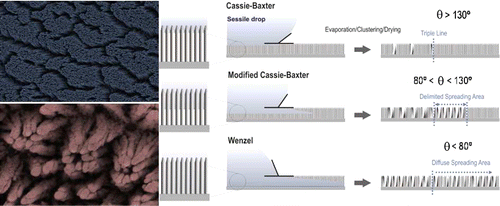M. Macías-Montero, A. Borrás, R. Alvarez, A.R. González-Elipe
Langmuir, 28 (2012) 15047−15055
doi: 10.1021/la3028918

This article aims toward a full description of the wetting conversion from superhydrophobicity to superhydrophilicity under illumination with UV light of high-density ZnO nanorods surfaces by (i) following the evolution of the clusters and superstructures formed by the nanocarpet effect as a function of the water contact angle (WCA); (ii) characterization of the superhydrophobic and superhydrophilic states with an environmental scanning electron microscope (ESEM); and (iii) using the nanocarpet effect as a footprint of both local and apparent water contact angles. Thus, the main objective of the article is to provide a general vision of the wettability of 1D photoactive surfaces. In parallel, the nanocarpet (NC) formation by clustering of vertically aligned ZnO nanorods (NR) when water is dripped on their surface and then dried is studied for the first time by taking advantage of the possibility of tuning the surface water contact angle of the ZnO NR structure under UV preillumination. As a result, we demonstrate the feasibility of controlling the size and other morphological characteristics of the NCs. Moreover, a strong anisotropic wetting behavior, characterized by a Δθ = θ∥ – θ⊥ = 30°, is shown on an asymmetrically aligned NC surface resulting from arrays of tilted NRs. The study of the condensation/evaporation of water on/from an as-prepared (superhydrophobic) or a preilluminated (superhydrophilic) NR surface examined by an environmental scanning electron microscope has evidenced the formation of supported water droplets with polygonal shapes in the first case and the complete filling of the inter-NR space in the latter. The long-term stability of the NC clusters has been utilized as a footprint to track the penetration depth of water within the inter-NR space in the three borderline regions of water droplets. This analysis has shown that for moderately hydrophobic surfaces (i.e., water contact angles lower than 130°) water droplets do not present a well-defined borderline trace but a spreading region where water penetrates differently with the NR interspace. The transition from a Cassie–Baxter to a modified Cassie–Baxter to finish in a Wenzel wetting state is found on these surfaces depending on the UV preillumination time and is explained with a model where water interaction with the NR units is the critical factor determining the macroscopic wetting behavior of these surfaces.

